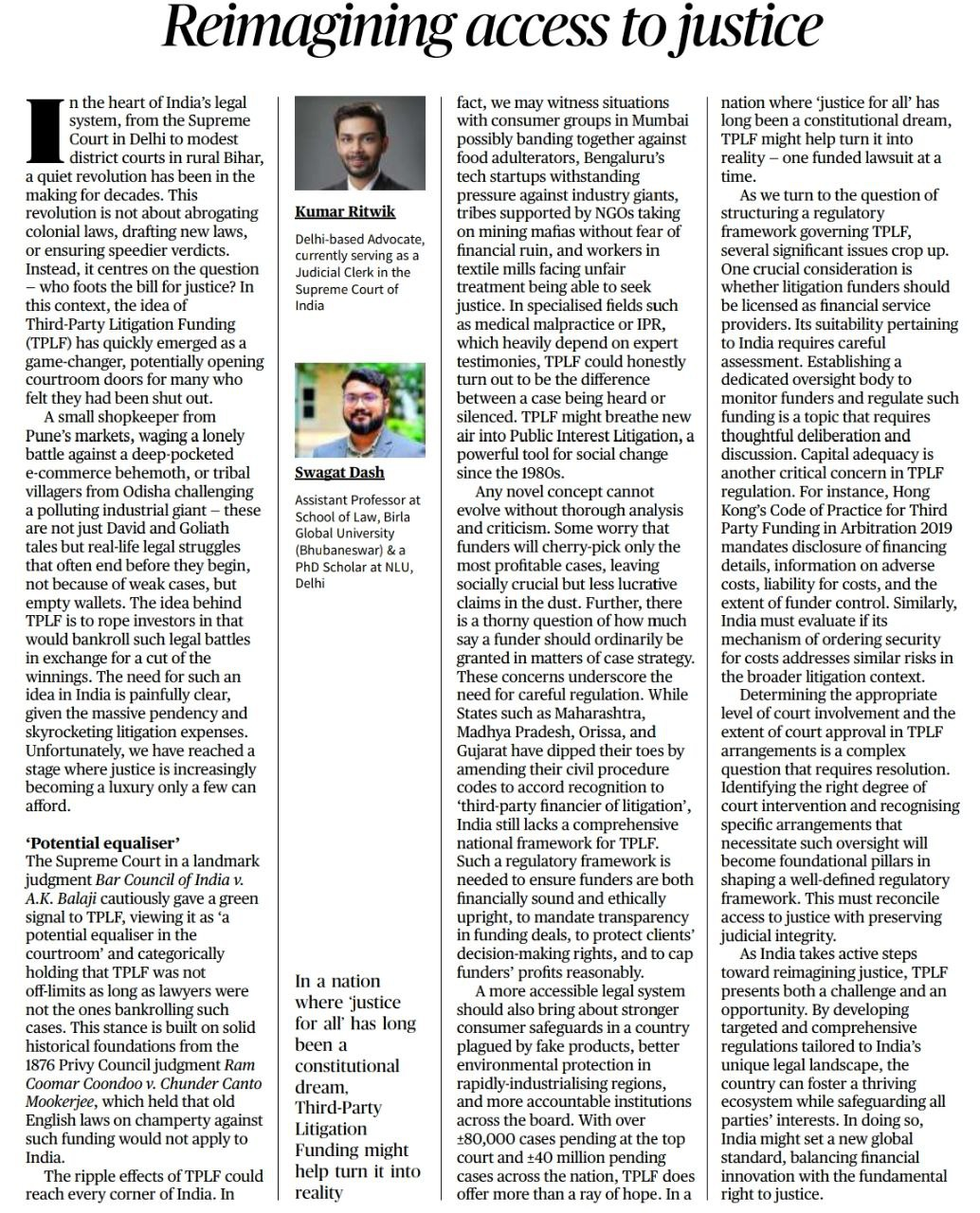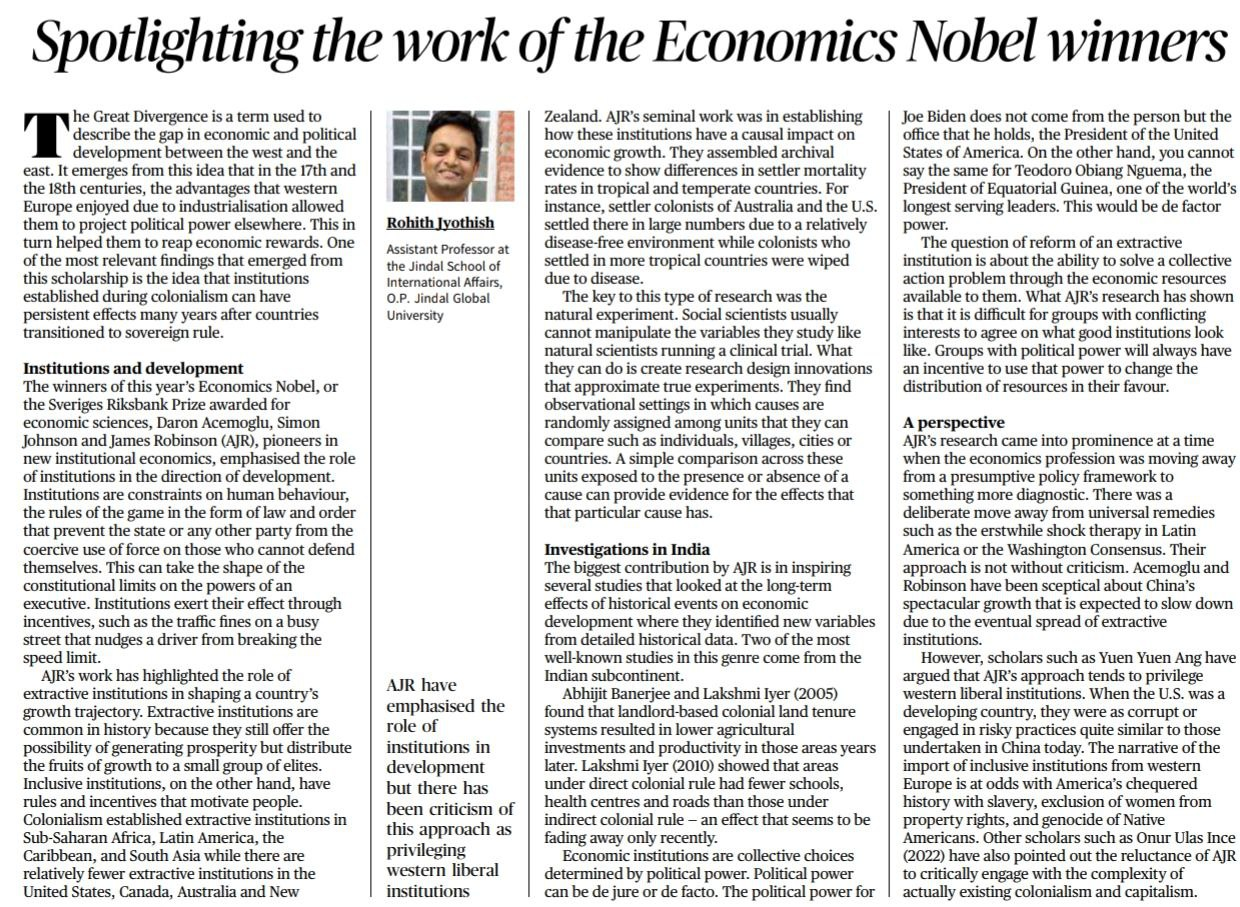1. Reimagining Access to Justice through Third-Party Litigation Funding (TPLF)
Introduction:
Access to justice is a fundamental constitutional right in India, but many citizens, especially those from economically weaker sections, struggle to exercise this right due to the high costs of litigation. Third-Party Litigation Funding (TPLF) has emerged as a potential solution, where private investors fund legal cases in exchange for a share of the settlement. This could be a game-changer in India’s judicial system, providing an avenue for marginalized litigants to fight for justice without the fear of financial ruin.
- What is Third-Party Litigation Funding (TPLF)?
- TPLF allows private investors or entities to fund the legal expenses of a litigant in exchange for a share of the financial outcome (e.g., damages awarded).
- It is commonly used in cases where the plaintiff lacks the financial means to pursue legal action.
- TPLF is particularly useful in complex and expensive litigations, such as medical malpractice, intellectual property rights (IPR), or corporate disputes.
- Judicial Support for TPLF in India:
- The Supreme Court in the case K. Balaji vs. Bar Council of India acknowledged TPLF as a legal option, marking it as a potential equalizer in the justice system.
- Historical precedents supporting TPLF date back to cases such as Ram Coomar Coondoo vs. Chunder Canto Mookherjee, establishing the foundation for third-party funding.
- However, lawyers are not permitted to fund litigation; only non-lawyer entities may do so.
- Benefits of TPLF:
- Equal Access to Justice: It can provide legal recourse to individuals who are otherwise unable to afford litigation, thus bridging the economic divide in accessing courts.
- Financial Security for Litigants: TPLF removes the financial burden from individuals and businesses, reducing the fear of bankruptcy due to prolonged litigation.
- Encourages Merit-Based Cases: Since funders typically invest in cases they believe have a strong chance of success, it encourages only meritorious lawsuits.
- Corporate and High-Value Cases: TPLF has significant potential in corporate law, arbitration, and public interest litigation (PIL), helping small businesses or individuals stand up to large corporations.
- Challenges and Concerns with TPLF:
- Regulatory Vacuum: India lacks a comprehensive national framework to regulate third-party funding in litigation. While states like Maharashtra, Madhya Pradesh, and Gujarat have taken steps, national legislation is required.
- Risk of Funders’ Influence: Without regulation, there is the risk that funders may exert undue influence on legal strategy, potentially compromising the integrity of the judicial process.
- Ethical and Transparency Concerns: There is a need for transparency in fund agreements, protection of client interests, and mechanisms to avoid frivolous litigation.
- International Examples of TPLF Regulation:
- Hong Kong: Implemented the Code of Practice for Third Party Funding in Arbitration in 2019, which mandates transparency in fund agreements.
- Australia: Developed extensive regulations governing funders’ roles, disclosure norms, and client protections.
- India could learn from these regulatory models to create a balanced framework.
Conclusion:
As India progresses toward making justice more accessible, Third-Party Litigation Funding (TPLF) offers both challenges and opportunities. With over 80,000 cases pending in the Supreme Court alone, a regulated TPLF regime could help alleviate the financial burden on litigants and provide broader access to justice. However, a carefully crafted legal and ethical framework is necessary to protect against potential abuse, ensuring that justice remains the paramount objective.
Practice Questions for UPSC Mains
|
|
2. Impact of Climate Change on Poor Farmers in India: Key Insights from FAO Report
Introduction:
The 2023 Nobel Prize in Economic Sciences was awarded to Daron Acemoglu, Simon Johnson, and James Robinson (AJR) for their contributions to the understanding of institutions and their role in economic development. Their research has reshaped how economists perceive the role of historical factors, particularly colonialism, and the long-lasting effects of extractive institutions on a country’s development. This approach is particularly relevant in the context of development economics and the study of disparities between countries.
- Key Concepts Introduced by AJR:
- Institutions: AJR emphasize that institutions—both political and economic—are crucial in shaping development outcomes. Institutions are the “rules of the game” that govern how individuals and the state interact.
- Extractive Institutions: Limit economic gains to a small elite, restricting broader economic participation and innovation. Common in many colonies.
- Inclusive Institutions: Foster economic participation and innovation across the population by providing incentives, protection of property rights, and political representation.
- Natural Experiments: AJR used historical events, like settler mortality in colonies, as natural experiments to study the impact of institutions on long-term growth.
- Historical Influence of Colonial Institutions:
- Colonial powers established extractive institutions in regions like Sub-Saharan Africa, Latin America, and South Asia, focusing on exploiting resources for the benefit of a few elites, which had long-lasting negative effects on these regions’ development.
- In contrast, inclusive institutions were established in regions like the United States, Canada, and Australia, where colonists settled in large numbers and built societies conducive to long-term economic growth.
- Key finding: The type of institution established during colonial rule influences economic performance even after independence.
- Case Studies in the Indian Context:
- Land Tenure Systems: Abhijit Banerjee and Lakshmi Iyer (2005) demonstrated how landlord-based tenure systems during colonial times in India led to lower agricultural investment and productivity.
- Colonial Rule: Lakshmi Iyer (2010) showed that areas under direct British rule had lower levels of infrastructure like schools and health centers compared to areas under indirect rule, highlighting the persistent impacts of colonial governance models.
- Political Power and Economic Institutions:
- De Jure and De Facto Power: AJR explain the difference between institutionalized political power (de jure) and personal political power (de facto). For example, the office of the President of the U.S. (de jure) vs. the personal political power held by long-serving autocrats like Teodoro Obiang Nguema of Equatorial Guinea (de facto).
- The struggle to reform extractive institutions involves overcoming collective action problems where groups with conflicting interests have to agree on what constitutes “good” institutions.
- Criticism of AJR’s Approach:
- Privileging Western Liberal Institutions: Scholars like Yuen Yuen Ang have critiqued AJR for focusing too much on Western liberal institutions and ignoring historical practices of corruption and exclusion in countries like the U.S. when they were developing.
- Reluctance to Engage with Colonialism: Critics like Onur Ulas Ince argue that AJR do not fully engage with the complexities of colonialism and capitalism in their analysis.
- China’s Growth: AJR are skeptical of China’s rapid economic growth, predicting its eventual slowdown due to the persistence of extractive institutions. However, others point out that China’s growth challenges some of the assumptions in AJR’s framework.
Conclusion:
The work of Acemoglu, Johnson, and Robinson has brought a new understanding of how institutions—especially those established during colonial times—can have long-term effects on economic growth.
While their contributions have influenced development economics and policy-making, their approach has also faced criticism for Western biases and underplaying the historical complexities of institutional development.
As nations continue to grapple with economic inequality and institutional reform, AJR’s research offers valuable insights, but also invites further debate and refinement.
Practice Questions for UPSC Mains |
1. Discuss the role of institutions in shaping long-term economic growth as highlighted by the work of the 2023 Economics Nobel laureates.
|



